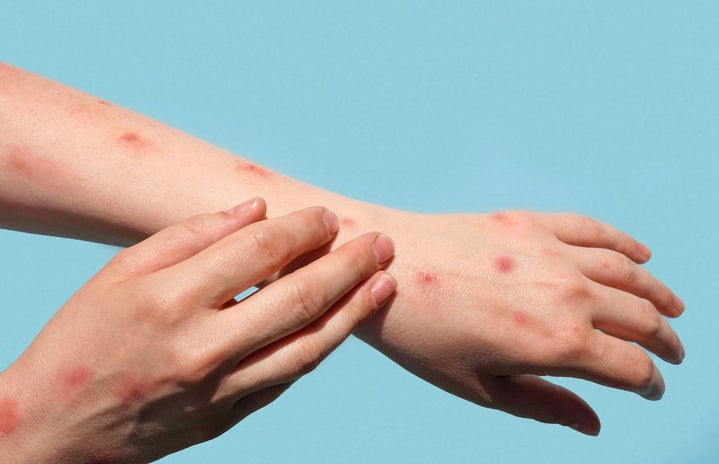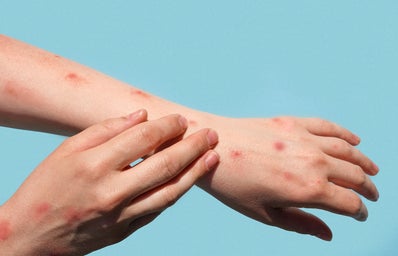Monkeypox is a virus that is infamous for inducing an itchy rash composed of pimples or blisters on many parts of the body — most noticeably on the face, hands, and feet. Monkeypox has recently become a cause for concern all over the world, with the first slew of non-endemic (“abnormal”) cases rising in Spain and Portugal in May. Most recently, New York issued a state of emergency over the spread, and it’s possible that other states could follow suit.
What are some symptoms to watch out for?
Monkeypox symptoms include:
- Fever
- Chills
- Rash, usually beginning one to three days from fever
- Swollen lymph nodes
The monkeypox virus is part of the same family of viruses as smallpox — the orthopoxvirus family — and is endemic in African countries. It was first discovered in 1958 in monkeys being help captive for research. Incidental human infections occur intermittently in the forests of Central and West Africa, when humans come into contact with animals that carry the disease. Contact can be both skin to skin, use of animal products in medicine or cultural practices, or by droplet exposure.
As deforestation and urbanization increase, people and hosts of various viruses will come into more intimate contact, thus increasing the chances of viral exposure and infection. Monkeypox is most likely to leap to people from rodents, according to the WHO, which is bad news, considering there are 2,000 species of rodents worldwide — this is 40% of all mammalian species.
In order to prevent exposure to monkeypox, you should:
- Use soap and water or alcohol-based sanitizer to clean yourself. Hand hygiene is very important.
- Mask up: Because the virus also is transmitted through large droplets in the air, wearing a certified surgical mask (or higher grade: KF94, KN95, N95) can protect you from both monkeypox and the novel coronavirus COVID-19 disease.
- If applicable, try to limit skin to skin exposure with unknown or public surfaces such as on trains and airplanes by wearing long sleeves and pants.
How has monkeypox been spreading?
From the beginning of 2022 until June 10, eight countries on the African continent reported 1,536 suspected cases. 59 of these were confirmed, with 72 deaths reported. Of the remaining laboratory confirmed cases, 11% are in the Region of the Americas, only 2% are composed of the African region, less than 1% in the Eastern Mediterranean region, and less than 1% in the Western Pacific Region. The remaining 86% are in the European region.
The first recent report by the WHO on monkeypox was completed on May 16, 2022. On May 7, WHO was informed of a confirmed case of monkeypox from an individual traveling between the UK and Nigeria. They had initially developed a rash as early as April 29 and returned to the UK on May 4. Contact tracing — identifying other people who came into contact with the infected individual — was completed in order to minimize the spread. During this report, the WHO believed that the risk of onward transmission was minimal due to the contact tracing.
The incubation period for monkeypox is usually six to 13 days, but can range from five to 21 days. The disease’s worst symptoms will usually resolve spontaneously by 14 to 21 days post-transmission.
Fast forward to the most recent monkeypox WHO report on June 27: It was reported that the majority of laboratory confirmed cases are currently being reported from the WHO European Region — 2,933 of 3,413 global cases (86%). This means that since June 10, cases doubled from roughly 1,500 to nearly 3,500 cases.
How deadly is it?
First, it is important to understand how often this virus leads to severe infection and fatality. There are two clades of the monkeypox virus that exist. Clades are a group of organisms that are monophyletic, meaning descended from a common ancestor. One is from West Africa; the other is known as Central African or the Congo Basin clade.
The West African (WA) clade has the potential to lead to severe illness but is mostly self-limiting, prompting the notion that outcomes of the West African clade are more dependent on individual genetics and their respective immune response. The fatality rate of WA is noted to be around 3.6%.
The Congo Basin (CB) clade, however, has a higher fatality rate that can be over 10%. As Nigeria is the main source of spread in the UK and Northern Ireland according to the WHO and GOV.UK, the strain spreading in the Western hemisphere is more often than not the WA clade.
With most cases presenting to be WA clade and therefore a lower fatality rate, it is unlikely that monkeypox, when contracted, is deadly. Unfortunately, the monkeypox virus has a high number of mutations which means a less deadly strain can evolve into a fatal one.
Compared to a strain from 2018, there are nearly 50 different changes according to preliminary analyses. How is it mutuating so quickly? Researchers in several countries found that of the 57 mutations, 42 carry the enzyme Apobec3 which was also found in H.I.V. What does this enzyme do? It causes intrinsic host resistance to different viruses by acting on viral genomes, thus inducing mutations.
Which groups are most at risk? Does this matter?
Everyone is at risk, but some less or more than others. Although monkeypox is defined by a rash on the hands and feet, many men with confirmed cases now have lesions on their genitalia, and may bare similar resemblance to sexually transmitted diseases (STDs) like syphilis, gonorrhea and chlamydia, it is not an STD.
Some researchers have even reported finding monkeypox DNA in semen. In early July, the San Francisco Public Health Department confirmed traces of monkeypox in the wastewater. More recently, both San Francisco and New York City have declared monkeypox a health emergency.
There has been heavy comparison of monkeypox with H.I.V. and AIDS due to the fact that men who have sex with men are especially vulnerable. The UK Health Security Agency (UKHSA) has said “a notable proportion” of the recent cases in the UK and Europe have been found in gay and bisexual men. Thus, the agency is encouraging members of these groups “to be alert to the symptoms and seek help if concerned.”
However, monkeypox is not limited to men who have sex with men.
Erica Susky, an Infection Control Practicioner (ICP) in hospital epidemiology, tells Her Campus that the monkeypox epidemic had been introduced to the LGBTQ+ community first. Thus, men who have sex with men and other queer individuals are not necessarily more susceptible to the virus than anyone else. “As more people get infected with monkeypox, it would be expected to affect a larger proportion of the population as more opportunities for contact and spread expand, as seen with the HIV pandemic,” Susky says.
How will monkeypox impact college campuses and student life?
Two disease experts spoke to Her Campus about the potential effects of monkeypox on college life.
Zuri Dale, MWM, MPH, currently working as an epidemiologist in Texas, stated that there was a huge reason to take monkeypox seriously on college campuses, as it “spreads primarily through close contact and exposure to an infected individual’s respiratory droplets, lesions, or bodily fluids. The congregate settings that many college students reside in do create a situation in which transmission can be increased.”
Dr. Armand Balboni, M.D., Ph.D., an infectious disease expert and Assistant Professor of Biology and Director of the Life Sciences Research Center at the United States Air Force Academy, Colorado, believes that the close physical contact necessary for transmission of monkeypox makes it less severe of a threat compared to COVID-19. However, Dr. Balboni tells Her Campus, “This is a critical moment to be watching and preparing for it to worsen and spread in many communities, including campuses.”
Dr. Balboni felt that the university response to COVID-19 was worth applause, but that pandemic preparedness as a whole was still lacking and vulnerable to outbreaks due to “the nature of most colleges and universities themselves — lecture halls, community dining halls, community dorms, the party scene. Universities can only do so much — eventually the social aspects of college will override many of the best practices, policies, and procedures.”
In agreement with Susky that those engaging in any kind of close contact, including sexual contact, are at risk of getting monkeypox from an infected person regardless of sexual orientation, Dr. Balboni says, “All students should be aware of the risks and educate themselves on how they can protect themselves against the virus.”
Dale hopes that this emerging public health concern can encourage universities to take action and “promote social distancing, but also take advantage of increased sex education, as co-infections with other infectious agents (such as chlamydia and gonnorhea) can occur which can make clinical diagnosis difficult.”
How can I take action now against infection?
Vaccines are available to select groups in the United States. The CDC states, “ACAM200 and JYNNEOS (also known as Imvamune or Imvanex) are the two currently licensed vaccines in the United States to prevent smallpox.”
Smallpox, part of the orthopoxvirus family that includes monkeypox, was successfully eradicated globally in 1980. No cases of naturally occurring smallpox have happened since then, and this is due to a successful vaccination campaign worldwide. Vaccines work, but it certainly helped that humans were the only species infected with smallpox variola and it spread fairly slowly. While it is doubtful that monkeypox will be eradicated, vaccines can help individuals’ immune systems prepare for a real infection.
Experts cautioned that the eradication of smallpox — and thus, exposure to the orthopoxvirus family — would result in viruses like monkeypox having better chances of evolving into a successful human pathogen.
Individuals who are exposed to monkeypox should also get the vaccine. The CDC recommends that the vaccine is given four days from the date of exposure in order to prevent disease onset.
ACAM2000 is a live Vaccinia virus that is inoculated into the skin by pricking the surface with the live species; if successful, a lesion is expected to develop at this site of vaccination. When individuals receive this, they must take precautions to prevent the spread of the virus because it is live. After 28 days, they are considered vaccinated. Vaccination with this smallpox vaccine is 85% effective in preventing monkeypox.
JYNNEOS vaccines are live but non-replicating, meaning the virus cannot grow in the body. It is administered as two subcutaneous injections into the fatty tissues below the dermis and above the muscle tissue with a period of four weeks between the first and second injection. It isn’t until the second dose that individuals are considered fully vaccinated.
Unfortunately, not everyone has access to the smallpox vaccines, which has been heavily criticized by epidemiologists.This is a concern because the JYNNEOS supply is lower than the demand and officials are considering administering with just one dose instead of two.
The lack of smallpox vaccine readily available is partially due to the fact that the U.S. and Canada discontinued ordering the smallpox vaccine. However, the US HHS has ordered 2.5 million more doses of JYNNEOS — the vaccine for smallpox and monkeypox — for monkeypox preparedness. Right now with the limited supply, vaccine eligibility is mostly limited to those at high risk of infection.
There is also an antiviral agent known as tecovirimat that was developed for smallpox originally and is currently being evaluated for monkeypox in 2022, according to the WHO.


